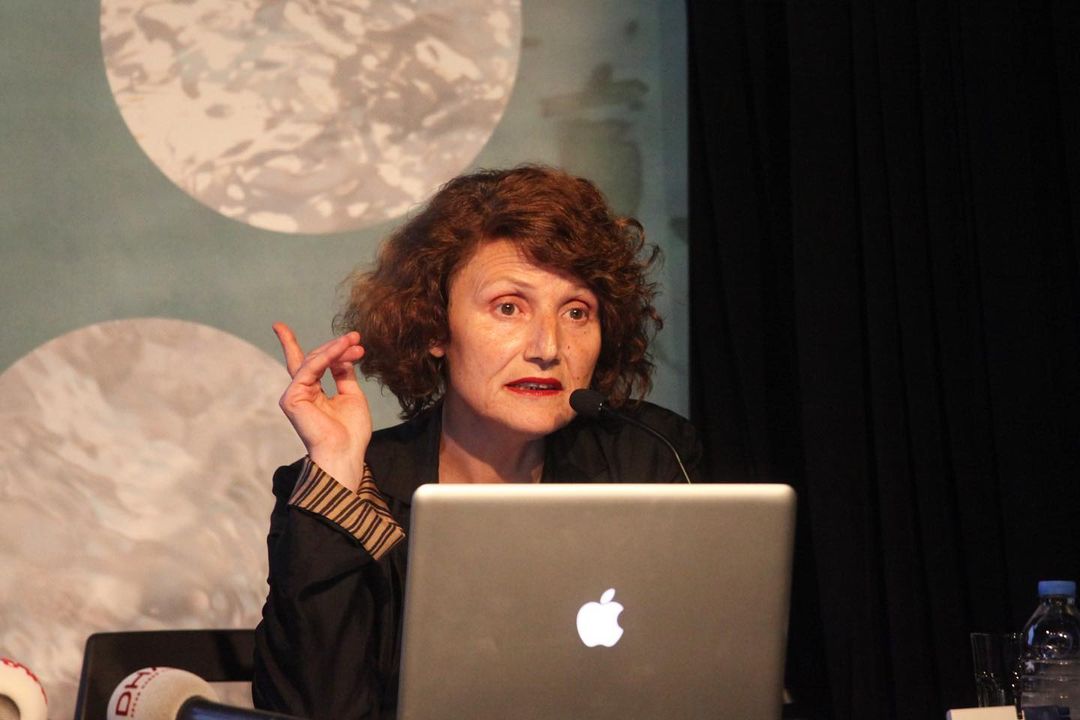Fulya Erdemci (1962–2022)
By HG Masters

Photo of FULYA ERDEMCI at the press conference of "Plan B," at Salon IKSV, Istanbul. Image via Instagram.
Turkish curator and former director of the Istanbul Biennial from 1994 to 2000, Fulya Erdemci died from cancer on July 13. Known for her interest in public art, Erdemci was involved in numerous exhibitions in Istanbul and internationally around the subject. She was the curator of the 13th Istanbul Biennial in 2013, which opened months after massive anti-government protests over the planned demolition of a public park in the city.
The Istanbul Foundation for Culture and Arts (İKSV) announced her death on Wednesday in a statement on social media and said its team would miss “her kind soul.” In 1994, Erdemci became the director of the fledgling Istanbul Biennial—established and run by İKSV—after receiving a graduate degree in art history from Columbia University in New York. Under her leadership, the organization expanded to be more prominent and international in its subsequent editions. She was then responsible for organizing the independent “Istanbul Pedestrian Exhibitions,” held in 2002 and 2005 (the latter in collaboration with curator Emre Baykal), which featured temporary installations and performances in public spaces and were the first of their kind in Istanbul. She was also involved in early contemporary art institutions in the city, working as the director of Proje 4L Elgiz Museum of Contemporary Art in 2003–04 and the temporary exhibitions curator at Istanbul Modern in 2004–05, before the museum building’s opening in 2007. As the curator of the İKSV-run Turkey Pavilion at the 54th Venice Biennale in 2011, she worked with Ayşe Erkmen, who is known for her public interventions at locations across Europe.
Erdemci was unexpectedly thrust into the spotlight as the curator of the 13th Istanbul Biennial in 2013, when massive anti-government protests erupted over the planned demolition of Gezi Park next to the Taksim Square. Many of the artworks that Erdemci had asked artists to propose for the Biennial were meant to be displayed in public spaces, but they had to readapt in the wake of the citywide protests. The Biennial’s memorable, provocative title “Mom, am I barbarian?” was taken from an essay by Istanbul poet Lale Müldür about the obeisance of Turkish poets in the 1980s to the idea of the West. For a 2013 profile [published in ArtAsiaPacific Issue 85], she told AAP: “I sincerely believe in the transformative power of art, particularly in the symbolic realm.”
As a curator, Erdemci worked at numerous international organizations over her career. She co-curated a portion of the Bienal de São Paulo in 2002 and worked on the Moscow Biennale in 2007. In 2008, she co-organized the fifth SCAPE, Christchurch Biennial of Art in Public Space in New Zealand with Danae Mossman. She was the director of the SKOR (Stichting Kunst en Openbare Ruimte) Foundation for Art and Public Domain from 2008 to 2012 and, since 2015, she served as the curatorial director of contemporary art at Cappadox, the festival of multidisciplinary arts held in the famous valleys and caves of the Cappadocia region.
Since 2020, she was the curator of Denmark’s KØS Museum of Art in Public Spaces. At the time of her appointment, she remarked: “The public domain is for me where the event happens: society meets, diverse thoughts are juxtaposed and dialogue begins . . . Today we experience ‘a new normal,’ which presents new challenges for the art world. We must expand ordinary exhibition formats and our idea of social life and interaction.”
HG Masters is ArtAsiaPacific’s deputy editor and deputy publisher.







